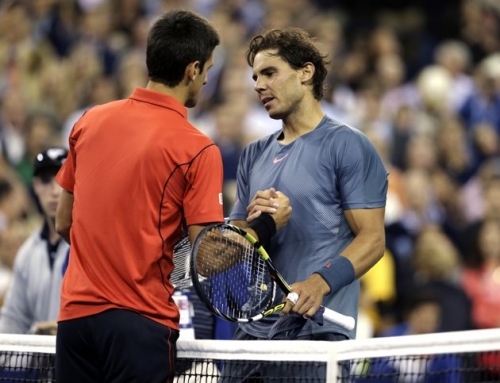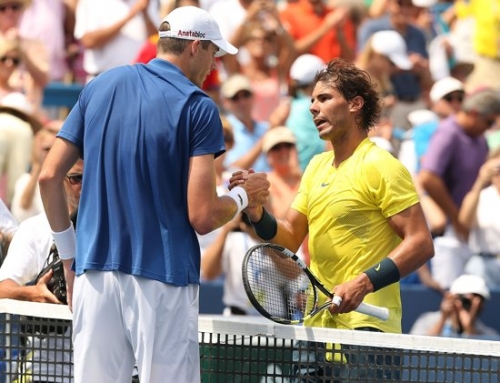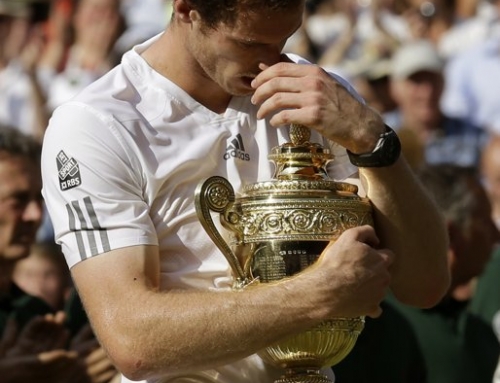 One only wonders what might have happened had Roger Federer not contracted mononucleosis. It shows, after all, that Roger Federer is human, susceptible to disease.
One only wonders what might have happened had Roger Federer not contracted mononucleosis. It shows, after all, that Roger Federer is human, susceptible to disease.
The timing was awful. It occurred late in 2007 or perhaps early in 2008, at a critical period for most tennis players.
Once upon a time, tennis players may have taken the winter off and treated it was a true off-season, one where rest and relaxation meant something. But these days, pros who want to keep their game up, to shore up deficiencies, to hone up strengths, use this period to train.
2008 was a year that showed cracks in the Federer armor. Up to then, his fallibility was only truly exposed by Rafael Nadal, and then, only on clay. By 2008, players like Djokovic and Murray were getting wins on Federer. Federer’s normally reliable groundstrokes were somehow a bit off-kilter. He was missing shots he used to make, shanking balls on his forehand. His first serve was also not as reliable as it once was. Federer was like some half-baked cake. It looked good on a cursory scan, but a bite showed something off.
2009 was an improvement, but Federer still had chinks in his armor. One could argue that Federer’s successful 2009 had much more to do with Nadal’s health than with Federer’s superior play. Federer was still losing to players like Djokovic and Murray, and increasingly, players like del Potro and Davydenko were finding ways to beat Federer.
The problem with the Australian Open coming so close off the heels of the December break is the lack of knowledge of what other players are doing to improve their tennis racquet swing. If Andy Murray had been privy to Roger’s training, he might have taken a different approach to the match.
Roger appeared to have worked on at least two aspects of his game. First, he needed to calm his forehand down so he wasn’t shanking the ball nearly as much. In the first round, he appeared to loop the ball more against Andreev. That shot went back to a flatter style as the tournament went along, but the loop appeared to be something of a safety shot, one he could go back to if his game was off, rather than give up the occasional shank.
The other part of his game that he appears to have spent a good deal of time on is his backhand. Federer has always known that his backhand was not as good as his forehand. It’s true of many players, but more so of Federer who hits that shot one-handed. Federer has always used his backhand as a multi-pronged tool, one capable of topspin and slice, and he’s always made prodigious use of his slice. Where female counterpart, Justine Henin feels like her slice isn’t a good enough weapon and has become more reliant on her topspin backhand, Federer has continued to rely on the slice.
But the topspin backhand is his bread and butter. Federer had often relied on his superior footwork to hit forehands. The problem with this style of play is how much court he leaves opened up by standing close to the left sideline. If Federer could hit his topspin backhand more reliably, more powerfully, then he’d give up less of the court, and part of hitting it more reliably was making the down-the-line backhand shot into more of a weapon. Without that, he’d constantly be defending off his backhand.
Federer used this strategy to good effect against Tsonga and was able to stand more in the center of the court for more points, and he continued to use his backhand more in the Murray match.
The question, when the match started, was what Andy Murray would do. Lacking the knowledge of what Federer had done in the off-season, Murray decided to pick on the Roger backhand. He played shot after shot to the backhand, and it was often as much his backhand that faltered rather than Federer. Federer, for his part, though a bit shaky at the start, playing his normal offensive self.
It didn’t help that Murray’s first serve percentage was around 40%. Murray’s first serve speed has increased over time, but lacking the natural reliability of Federer’s serve, he has as many bad days as good. In the first set, Murray’s first serve percentage was a paltry 45% to Federer’s 65%.
Murray began to alter his strategy more in the second set, trying to be a bit more offensive, but never got to break point on Federer’s serve while Federer had several chances on the Murray serve and eventually engineered a break.
The third set saw Murray willing to move Federer around. Rather than simply attack the backhand, the goal was to hit a shot to Federer’s forehand, then to his backhand. Federer, meanwhile, was looking for his usual opening to hit either a hard shot inside out or to whip a shot crosscourt.
Murray did eventually get an break in the middle of the third set, but as he served for the set at 5-4, Federer made a push and broke back to 5-all. Federer held to 6-5, and Murray pushed it to a tiebreak at 6-all. The tiebreak went back and forth with Murray having early chances at set points and Federer having chances at match points. In one particularly exciting point, Federer hit a drop shot that Murray barely chased down and sliced down the line. Federer pulled his racquet away and saw it land in, as Murray saved match point.
Eventually, at 12-11 down, Murray decided to pull the trigger up-the-line, and found the net. Federer crumpled to the ground, excited once again at another Slam victory.
Murray’s thinking about tennis is, in many ways, rather profound. A tennis teacher will tell a pupil that tennis, like many sports, is a game of errors. Cut down on the number of errors and you win more games. Except Murray’s game isn’t quite built like that. Murray isn’t a heavy topspinner in the mold of Nadal or even Federer. Murray’s game is quite a bit flatter, and so his margin of error isn’t nearly as good. Murray is also not nearly as conservative as Andy Roddick. Murray’s error count per set is therefore rarely in the single digits.
Instead of trying to cut down his own errors, Murray often tries to induce errors in others. He does this by changing pace, hitting topspin, then slice. He also uses his court coverage to chase down shots that would be winners against most players. This style of play depends on the fragility of the other player’s hitting style.
Roger Federer has used his practice time to withstand changes in pace and direction to allow him to play his brand of offensive tennis. Federer is always looking for an opening to play a power shot, mostly of the inside-out variety. Although his philosophy is completely different, Davydenko tries to do the same thing. Federer is a corner-to-corner opportunist. Davydenko prefers to hit his winners up-the-line or from the center of the court to the corners. Even so, Davydenko’s purpose is to find an opportune moment to pull the trigger, which is why he find success against players like Nadal.
Indeed, Nadal’s strategy seems to echo Murray’s strategy. Nadal is very stingy on errors, making very few of them. Instead of waiting for errors, Nadal’s goal is to hit his heavy topspin shot and eventually find a shot with a weak return to pounce on, then to press on a weakness over and over until he gets an error or until he makes the winner. You always feel with Nadal, that he avoids the outright winner, and prefers hitting a shot that you can get to, but struggle with, so then he can start to work that shot.
But despite the different methodology, there is the idea that the opponent should either produce an error or at least a weak shot to work on, and that winners should not be attempted willy-nilly.
So what does Andy Murray do now? Murray has stubbornly clinged to the idea that you can beat a player by inducing errors from them. Roger Federer has shown, at his best, he can produce a sustained offense and that, at least, for now, Murray can’t withstand. Without more of a punch in his game, Murray is left scrambling around.
If Murray decides to use this time to build more offense in his playing style, he’ll need to do it more often, against players of all sorts, rather than just trot it out for Federer. One reason he may be avoiding this style is the amount of work it takes to play this way. Another may simply be a stubborn belief that you can win without this style.
This loss is interesting because of what it says about Andy Murray’s ability to rebound. For now, it seems Roger is back and looking to alter his style just enough so he can rely more on his backhand. What will Andy do next? Only time will tell.




![[US Open Men’s Final] Can Djokovic beat Nadal in the finals?](https://www.essentialtennis.com/wp-content/uploads/2013/09/20130909djokovic-500x383.jpg)


![[French Open] The tactics of the Djokovic-Nadal semifinals](https://www.essentialtennis.com/wp-content/uploads/2013/06/20130607nole-500x383.jpg)